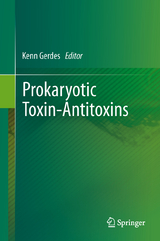Prokaryotic Toxin-Antitoxins
Seiten
2012
|
2013
Springer Berlin (Verlag)
978-3-642-33252-4 (ISBN)
Springer Berlin (Verlag)
978-3-642-33252-4 (ISBN)
Prokaryotic Toxin-Antitoxins gives a brief and clear overview of a complex and rapidly expanding research field of scientific, biotechnological and medical importance.
Prokaryotic Toxins - Antitoxins gives the first overview of an exciting and rapidly expanding research field. Toxin - antitoxin (TA) genes were discovered on plasmids 30 years ago. Since then it has become evident that TA genes are highly abundant in bacterial and archaeal chromosomes. TA genes code for an antitoxin that combine with and neutralize a cognate toxin. When activated, the toxins inhibit protein synthesis and cell growth and thereby induce dormancy and multidrug tolerance (persistence). Remarkably, in some species, the TA gene families have undergone dramatic expansions. For example, the highly persistent major human pathogen Mycobacterium tuberculosis has "100 TA loci. The large expansion of TA genes by some organisms is a biological mystery. However, recent observations indicate that TA genes contribute cumulatively to the persistence of bacteria. This medically important phenomenon may thus for the first time become experimentally tractable at the molecular level.
Prokaryotic Toxins - Antitoxins gives the first overview of an exciting and rapidly expanding research field. Toxin - antitoxin (TA) genes were discovered on plasmids 30 years ago. Since then it has become evident that TA genes are highly abundant in bacterial and archaeal chromosomes. TA genes code for an antitoxin that combine with and neutralize a cognate toxin. When activated, the toxins inhibit protein synthesis and cell growth and thereby induce dormancy and multidrug tolerance (persistence). Remarkably, in some species, the TA gene families have undergone dramatic expansions. For example, the highly persistent major human pathogen Mycobacterium tuberculosis has "100 TA loci. The large expansion of TA genes by some organisms is a biological mystery. However, recent observations indicate that TA genes contribute cumulatively to the persistence of bacteria. This medically important phenomenon may thus for the first time become experimentally tractable at the molecular level.
Introduction.- Type I Toxin - Antitoxin Systems: Hok / Sok and Fst .- Novel Type I Toxin - Antitoxin Systems.- Type II TA Loci: The Ccdab and Parde Families.- Type II TA Loci: The Relbe Family.- Type II TA Loci: The Unusual Mqsra Locus.- Type II TA Loci: The Mazef Family.- Type II TA Loci: Vapbc and Other TA Loci In Mycobacteria.- Type II TA Loci: Phd Doc Family.- Type II TA Loci: The Fic Family.- Type II TA Loci, Hipab And Persisters.- Type II TA Loci: Zeta / Pezt Family.- Type II Loci: Phylogeny.- Type III TA Loci.- TA Loci Encoded By Plasmids.- TA Loci in Archaea.- TA Loci in Mycobacterium Tuberculosis .- TA Loci in Streptococcus Pneumoniae .- Biotechnological and Medical Exploitations Of TA Genes and Their Components.
| Erscheint lt. Verlag | 19.10.2012 |
|---|---|
| Zusatzinfo | VIII, 368 p. |
| Verlagsort | Berlin |
| Sprache | englisch |
| Maße | 155 x 235 mm |
| Gewicht | 691 g |
| Themenwelt | Naturwissenschaften ► Biologie ► Mikrobiologie / Immunologie |
| Schlagworte | Apoptosis • Bacteria • Messenger RNA • Pathogens • Persistence • Prokaryonten • RNA degradation • Toxine • Virulence |
| ISBN-10 | 3-642-33252-8 / 3642332528 |
| ISBN-13 | 978-3-642-33252-4 / 9783642332524 |
| Zustand | Neuware |
| Haben Sie eine Frage zum Produkt? |
Mehr entdecken
aus dem Bereich
aus dem Bereich
Allgemeine Grundlagen und spezielle Anwendungen
Buch | Softcover (2021)
Springer Berlin (Verlag)
54,99 €




